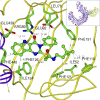Identification of substituted pyrimido[5,4-b]indoles as selective Toll-like receptor 4 ligands
- PMID: 23656327
- PMCID: PMC3722616
- DOI: 10.1021/jm301694x
Identification of substituted pyrimido[5,4-b]indoles as selective Toll-like receptor 4 ligands
Abstract
A cell-based high-throughput screen to identify small molecular weight stimulators of the innate immune system revealed substituted pyrimido[5,4-b]indoles as potent NFκB activators. The most potent hit compound selectively stimulated Toll-like receptor 4 (TLR4) in human and mouse cells. Synthetic modifications of the pyrimido[5,4-b]indole scaffold at the carboxamide, N-3, and N-5 positions revealed differential TLR4 dependent production of NFκB and type I interferon associated cytokines, IL-6 and interferon γ-induced protein 10 (IP-10) respectively. Specifically, a subset of compounds bearing phenyl and substituted phenyl carboxamides induced lower IL-6 release while maintaining higher IP-10 production, skewing toward the type I interferon pathway. Substitution at N-5 with short alkyl substituents reduced the cytotoxicity of the leading hit compound. Computational studies supported that active compounds appeared to bind primarily to MD-2 in the TLR4/MD-2 complex. These small molecules, which stimulate innate immune cells with minimal toxicity, could potentially be used as adjuvants or immune modulators.
Figures













References
-
- Dev A.; Iyer S.; Razani B.; Cheng G. NF-κB and innate immunity. Curr. Top. Microbiol. Immunol. 2011, 349, 115–143. - PubMed
-
- Li Q.; Verma I. M. NF-κB regulation in the immune system. Nature Rev. Immunol. 2002, 2, 725–734. - PubMed
-
- Hemmi H.; Takeuchi O.; Kawai T.; Kaisho T.; Sato S.; et al. A Toll-like receptor recognizes bacterial DNA. Nature 2000, 408, 740–745. - PubMed
-
- Prins R. M.; Craft N.; Bruhn K. W.; Khan-Farooqi H.; Koya R. C.; et al. The TLR-7 Agonist, Imiquimod, Enhances Dendritic Cell Survival and Promotes Tumor Antigen-Specific T Cell Priming: Relation to Central Nervous System Antitumor Immunity. J. Immunol. 2005, 176, 157–164. - PubMed
Publication types
MeSH terms
Substances
Grants and funding
LinkOut - more resources
Full Text Sources
Other Literature Sources
Molecular Biology Databases

